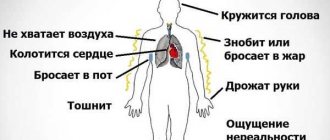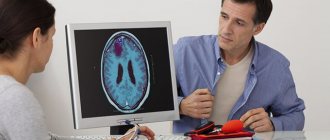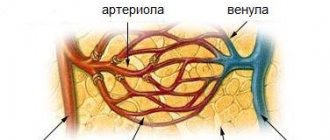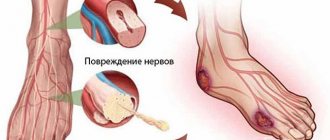0
Author of the article: Marina Dmitrievna
2017.10.30
56
Vessels
Vegetative-vascular dystonia is a diverse and multifaceted disease that affects the entire body and some of its functions. There is a subtype of VSD that negatively affects the blood vessels of the brain, which leads to tangible consequences for the whole organism.
How are the VSD and cerebral vessels interconnected, what symptoms can be used to understand that they need to be strengthened, and how, in fact, to do this?
VSD
What is dystonia?
The concept of dystonia itself implies problems with the nervous system. The autonomic apparatus is divided into the sympathetic and parasympathetic systems. Depending on the needs of the body, they give opposing commands to the organs, for example, to constrict and dilate the pupil in the dark or influence the capacity of blood vessels.
When the autonomic system malfunctions due to stress, poor lifestyle, and weakness of the body, the body receives incorrect commands. The vessels are responsible for filling it with blood, which, in turn, saturates it with nutrients and removes metabolic products, creates stable pressure, controls the filling of cells with oxygen and the removal of carbon dioxide from them. To do this, the walls of blood vessels narrow when it is necessary to reduce blood flow or expand to increase it.
Reasons for development
As a result, vegetative-vascular disorder leads to incorrect “behavior” of blood vessels in the brain, giving them false commands from the autonomic nervous system, which deprives the brain of the necessary nutrition. This leads to the corresponding symptoms.
Angiospasm: symptoms
With frequent spasms, the elasticity of blood vessels is lost and there is a constant lack of oxygen.
Symptoms include numbness in the hands - blood does not flow through the capillaries, the hands become numb and lose sensitivity. Acrocyanosis is characterized by spasm of the leg vessels.
During a spasm, the skin turns white, it looks like “marble”, then it turns blue - the lack of oxygen manifests itself and turns red when the blood passes through the capillaries again.
Spasm of the coronary arteries of the heart begins with painful discomfort in the chest, and symptoms of angina pectoris are present.
Spasm of blood vessels leads to vascular crisis, when narrowing of the walls causes disturbances in the blood supply to organs and tissues. The vessels of the heart, head, and eyes are affected.
In the absence of appropriate treatment for cerebral spasms, there is a possible risk of heart attack, stroke, thromboembolism, and coronary artery disease.
Symptoms of VSD
In order to recognize dystonia in time and understand how to strengthen the walls of brain vessels during VSD, you need to know the symptoms of the disease well. It is worth talking about this disease more often, since, according to doctors, dystonia occurs in one form or another in 40% of the population.
Symptoms of dystonia:
- Headache often and for a long time. The pain is not sharp, aching, suppressing the mood;
- Tinnitus for no apparent reason;
- Unexpected dizziness up to loss of orientation;
- Frequent groundless panic, manifestation of spontaneous and causeless fears, constant anxiety and restlessness;
- The mood is constantly changing, the changes are sharp and contrasting;
- Irritability, impatience with others, constant nervousness, desire to fiddle with something in your hands, draw, pull or touch;
- Constant drowsiness even with normalized regular sleep, often want to sleep during the day;
- Occasionally a person feels like he is suffocating, there is not enough oxygen, but this feeling should not be acute;
- A trembling occurs, similar to a nervous one;
- Bags under the eyes appear sharply, the face swells and swells.
Characteristic symptoms
All these ten points characterize vascular dystonia of the brain, however, there are also certain consequences for the whole body, which further depress the body:
- Pain in the heart without noticeable pathologies, acceleration or deceleration of its beat for no reason;
- Throws you into sweat, then into cold, hands and feet are often cold;
- Frequent fainting, sensitivity to changes in weather, constant change in complexion from crimson red to pale;
- Sudden surges in blood pressure, nosebleeds;
- A woman with VSD endures “critical days” much harder; her body reacts more sharply to hormonal surges during VSD.
At the same time, a patient with vegetative-vascular dystonia feels general weakness, a reluctance to move, even just to get up from the sofa or bed. The disease causes apathy and other symptoms of melancholy and depression.
It is worth considering that lethargy is a symptom characteristic of other diseases of the human body.
Antipsychotic drugs
Such medications should be chosen based on their main component. It is better to give preference to sedatives made from plant extracts.
The following medications are also recommended for VSD in adults:
- "Novo-passit";
- "Persen";
- "Dormiplant";
- "Sedaphyton".
Sometimes stronger medications are prescribed (a mixture of herbal remedies and barbiturates):
- "Valocardin";
- "Barboval";
- "Corvalol".
Used to normalize heart rate and blood pressure. Reduce irritability, nervousness and aggressiveness.
Effective drugs:
- "Neurispin";
- "Ridazine";
- "Sulpiride".
Designed to combat depression, apathy, decreased activity and reluctance to take any action.
Representatives of antidepressants are:
- "Amitriptyline";
- "Sidnofen";
- "Paroxetine";
- "Coaxil";
- "Sertraline";
- "Cymbalta."
Helps restore concentration and memory. They help overcome dizziness during VSD, headaches, as well as general weakness of the body.
Excellent medicines are:
- "Glycine";
- "Piracetam";
- "Pantogam";
- "Noofen."
In addition to nootropics, you can also take neurometabolites:
- "Cerebrolysin";
- "Actovegin".
These kinds of drugs are necessary to normalize blood circulation in the brain and eliminate headaches.
The following agents are effective in treating pathology:
- "Cavinton";
- "Stugeron";
- "Pentoxifylline";
- "Oxybral".
Such medications are quite often prescribed to patients. Therefore, let's look at some of them:
- Taking the drug Cavinton (the price of which is not at all high) improves cerebral blood supply, dilates blood vessels, and helps to utilize glucose more efficiently. This effect is achieved due to the relaxing effect of the product on smooth muscle tissue. Another positive aspect of the drug is an increase in the plasticity of red cells in the blood and a decrease in its viscosity. However, it is worth knowing about its pitfalls. Sometimes the medicine Cavinton helps to slightly lower blood pressure. The price of this medication is 252 rubles for 50 tablets.
- The effect of the drug "Stugeron" is also aimed at dilating blood vessels. However, unlike its counterpart described above, it has little effect on blood pressure levels. This is its undoubted advantage. In addition to everything, the drug "Stugeron" has antihistamine properties. It reduces the excitability of the sympathetic nervous system and gives elasticity to red blood cells. This is how the instructions for the drug “Stugeron” characterize it. Reviews from patients indicate that using this drug as prescribed can significantly improve the condition and eliminate many negative symptoms.
The pathology can develop according to the hypotonic or hypertonic type. Accordingly, in the first case the patient suffers from low blood pressure. Whereas in the second situation the indicators can reach high numbers. When prescribing medications, the doctor must take into account the VSD types.
Treatment to lower blood pressure may include the following medications:
- "Anaprilin";
- "Bisoprolol";
- "Metoprolol."
Completely different medications are needed for patients who have hypotonic pathology.
The spectrum of action of this type of medicine is quite wide. By influencing the parasympathetic and sympathetic nervous systems, they eliminate various pains, susceptibility to excessive sweating and improve the general condition of a person emotionally.
Representatives of vegetotropic drugs are:
- "Platifillin";
- "Bellataminal";
- "Bellaspon."
Like cerebroangiocorrectors, these medications are aimed at improving cerebral circulation and its supply with necessary substances.
https://www.youtube.com/watch?v=wb0Hm8YJjiA
Excellent antioxidants are medications:
- "Succinic acid";
- "Mexidol";
- "Vitrum-antioxidant";
- "Cratal."
In the modern medical market, the palm in terms of the effectiveness of its antioxidant properties belongs to the relatively young drug Mexidol.
This product has a very large list of advantages:
- increases concentration and stress resistance;
- improves memory, sleep;
- prevents coronary heart disease;
- strengthens the immune system;
- reduces pain by lowering the body’s general sensitivity threshold;
- promotes better oxygen saturation of the brain.
The medicine is quite effective and practically does not cause side effects, as evidenced by the instructions for the drug Mexidol.
Analogues of this medication with the same properties:
- "Neurox";
- "Mexidant";
- "Cerekard";
- "Mexipridol";
- "Medomexy".
Who is at risk?
Vegetative-vascular dystonia, like any other disease in the body, does not arise out of the blue. Although it does not cause serious health problems, it significantly worsens a person’s quality of life. Here is a list of factors that put people at risk:
- Frequent stress, which greatly affects the nervous state and behavior of blood vessels in the brain;
- Troubles that keep a person under serious stress for a long time;
- Genetic predisposition – initially insufficiently elastic brain vessels;
- Focal infections in the brain and the body as a whole;
- Changes in hormonal levels - during menopause, dystonia is most likely;
- Cranial injuries, brain damage;
- Poor lifestyle – frequent use of alcohol, tobacco, drugs and unhealthy food;
- Osteochondrosis of the cervical vertebrae, blocking blood access to the brain;
- Frequent excessive sports stress on the body;
- Exposure to radiation or chemical intoxication;
- Lack of sleep and climate change, the body’s reaction to it.
Provoking factors of VSD
Medicines
It is better to give preference to new generation products. They have an extended spectrum of action and a minimal number of side effects.
The following drugs are used to strengthen blood vessels:
Noofen is taken by people who have suffered traumatic brain injuries. The drug increases the number of mitochondria. These are cells that help produce energy. If they are in sufficient quantities in the body, flexibility and permeability improve.
Phezam. A combination product containing Cinnarizine and Piracetam. Increases the concentration of carbon dioxide in the blood, which adapts brain cells to hypoxia. The medicine also strengthens capillaries.
Actovegin. A long course of use of the drug helps eliminate spasms, cholesterol plaques, and reduces the likelihood of blood clots.
The vitamin complex helps improve the functionality of veins and arteries. Let's figure out how different beneficial substances affect their condition:
- Retinol improves metabolism and reduces the chances of developing atherosclerosis.
- Ascorbic acid reduces the concentration of high-density lipoproteins, the walls of veins and arteries become stronger.
- Tocopherol belongs to the category of antioxidants, eliminates fat oxidation, and helps protect the walls of blood vessels.
- Rutin strengthens capillaries and promotes better regeneration.
- Polyunsaturated acids help prevent the appearance of fatty deposits on the walls of blood vessels.
- B vitamins are essential for the circulatory system of the brain. Lipid metabolism is stabilized due to their action. The decomposition of low-density lipoproteins and their detection are stimulated.
Minerals:
- Calcium in combination with vitamin D helps strengthen blood vessels, reducing their fragility and fragility.
- Magnesium prevents blood clots, improves blood pressure, deformation of veins and arteries, increases their tone, and the walls become relaxed.
- Phosphorus strengthens the formed elements of vascular tissues and improves the movement of nerve impulses.
- Selenium helps strengthen veins, arteries, capillaries by improving metabolic processes.
You can use some vitamins for a long time. The effectiveness of treatment is ensured thanks to the vitamin-mineral complex.
Consider a list of drugs consisting of several beneficial substances for the blood vessels of the head:
- Ascorutin. The medicine contains vitamins C and P, which stabilizes recovery processes. The fragility of capillaries worsens, the walls of blood vessels become strong and flexible.
- Hawthorn promotes healthy capillaries, eliminates inflammation, and has an antiviral and antispastic effect.
- Vitrum cardio omega-3 reduces the chances of atherosclerosis. The medicine eliminates triglycerides, high and low density cholesterol. The cell structure is strengthened, the elasticity of blood vessels is restored.
- Direction makes the arteries stronger, blood circulation in the head is stabilized, the likelihood of developing atherosclerosis is reduced, and vascular regeneration is improved.
- Cardiohealth. A herbal remedy that helps strengthen vascular tissue, the microcirculation process is stabilized, the elasticity of the arteries increases, and cholesterol is produced in a smaller volume.
When purchasing drugs that strengthen the blood vessels of the head, you need to carefully follow the list of contraindications and follow the dosage.
What are the ways to strengthen blood vessels?
Conventionally, methods of strengthening blood vessels for dystonia are divided into three parts. The first is medications, including tablets and ointments for local use. They are used for problems with cerebral vessels that arise as a result of serious diseases and disorders of the body, and not for VSD.
For example, such a drug is heparin or hormonal ointment. In case of VSD, their use is usually unjustified, especially frequent, since this problem can be solved in ways that are more friendly to the body. Sometimes they take mild painkillers to relieve obsessive headaches caused by VSD.
The second part is folk methods, decoctions and herbs that act slowly, easily and unobtrusively, improving the overall health of the body and brain. Within reasonable limits, this is useful for the treatment and prevention of VSD. To increase the effectiveness of treatment, there is a third part - physiotherapy, sufficient sports activities, proper nutrition and sleep patterns. All this will not only overcome cerebral vascular dystonia over time, but will also take your overall shape, mood and appearance to a qualitatively new level. Let's take it in order.
Drug therapy
What treatment is recommended for people suffering from VSD? Drugs that can help with this pathology are a huge list of medications. After all, the disease is characterized by too large a list of symptoms.
However, this does not mean that all drugs listed on this list must necessarily be included in the treatment program. It's just the opposite.
Prescribing an excessive amount of pharmacological drugs to a patient is the highest sign of doctor incompetence. After all, such an approach will not only not help in curing the disease, but will also significantly worsen the situation.
Don’t forget about this if you need treatment for VSD.
Drugs designed to combat both the symptoms of the disease and the disease itself are divided into several groups.
Daily regimen for vascular dystonia
Home and work daily routine is one of the fundamental means for maintaining normal blood vessels in the body and brain. It should be organized like this:
- On any day of the week, get up at approximately the same time - the difference should be a maximum of an hour. If you want to lie down on the weekend, you should wake up and stretch in bed, daydream or read. The latter “wake up” the brain in the morning much better than coffee.
- If you have VSD, you should pay attention to exercises, maybe the simplest ones, taken from physical education lessons, this will help disperse the blood and restore vascular tone;
- A mandatory breakfast with cottage cheese or sour cream and complex carbohydrates - porridge, or sweet, with fruit and sugar, or preferably honey. Before meals - a glass of water, during - 100-150 ml of juice, but after all this you can indulge in a cup of coffee. If you have problems with blood pressure, it is better to dilute it with milk, it is healthier for the body.
- The working day should be interrupted as often as possible for light snacks, which should include not only sandwiches, but also fruits and vegetables that nourish the brain. It’s better to eat a delicious tomato with a piece of meat during a break, which is no less tasty than a piece of bread with sausage, hastily assembled in the morning. This is much more useful for VSD.
- It’s worth going outside 2-3 times, at least for a minute or two, and “breathing.” At this time, you should often do simple exercises - rise on your toes, tuck your legs in turn, jump slightly. Important – we are not talking about smoking breaks!
- A hearty dinner, most of which consists of vegetables in any form except heavily fried.
- An evening walk with the whole family - for this it is worth getting a dog that you can walk - an excellent motivation and a reason to throw out excess childish energy before going to bed, getting rid of your own dystonia.
If you have dystonia, you should drink a lot of water - for an adult, about 1.5 - 2 liters and remember that the body perceives only H2O in this way, and all other drinks - juices, coffee, tea, uzvar, drinks and compotes are food for it, which he digests!
Recommendations for the prevention of VSD
Nutrition
Eating according to all the laws of “correctness”, even feeling the discomfort of dystonia, is often difficult and unusual. To help the vessels “get rid” of dystonia, one important condition should be observed - plant foods should significantly predominate in the diet. It is worth leaning on vegetables, fruits, seaweed in raw, dried and stewed form. Porridges and legumes should be present on the table regularly; it is often recommended to cook buckwheat and rice, which is especially good for VSD and for the body in general.
To make it tastier, you should add fish to this, any fish except smoked. It should be excluded altogether, especially during periods of exacerbation. Literally a medicinal product - fatty fish with polyunsaturated fatty acids. These are red species and, if cheaper, regular mackerel. You should treat baked goods of any kind, as well as starchy products - potatoes, corn, etc. with caution, eat a little, only in the morning and after a hearty breakfast.
Meat is also relevant, but in small quantities. It is better to eat stewed or boiled beef and poultry. A rabbit is also possible. Very bad - fried pork, tasty, but not for vessels.
It is worth using cold-pressed sunflower and olive oil in salads, and if you infuse it with Provençal herbs for several weeks in a dark place, it will replace any ordinary “cholesterol” sauce.
Proper nutrition will solve most problems
Vitamins and herbs
The traditional method of treating VSD is based on herbal decoctions and other natural products to compensate for the lack of “benefits” in the body, which stimulate the restoration and strengthening of the walls of brain vessels. These include vitamins C, A, E, B, K and PP.
You can get them for VSD in the following ways:
- Grind prunes, lemons straight with skins, dried apricots and walnuts. Add 50 grams of vegetable oil, preferably cold-pressed, and the same amount of liquid honey. Eat a teaspoon after morning and evening meals.
- Jam and fresh berries of cranberries, rose hips, rowan berries, hawthorn, currants and cherries are a valuable source of nutrients. It's best to eat them straight with a spoon without any processing.
- For vegetative-vascular dystonia of the brain, it is worth drinking decoctions of red clover, cucumber, Japanese sophora, and it is good to use barberry - bark and leaves. Pour a tablespoon of dry raw material into 200 ml a glass of boiling water and leave.
A folk remedy for the prevention of VSD should be discussed with your doctor, especially if you have other diseases. For example, if you have diabetes, you should not use the first recipe - the blood glucose level may rise dangerously. An important condition is that decoctions and mixtures should be consumed in limited quantities!
To prevent problems with blood vessels and even during exacerbations of VSD, you should pay attention to sports. The best exercise is dancing, and it doesn’t matter whether it’s fast or slow, flexible or fun - such exercise is beneficial for the body. You can train the blood vessels of the whole body, including the brain, by simply bending the body in all four directions - this is a good idea for regular morning exercises.
When wondering how to train blood vessels with vegetative-vascular dystonia, it is worth paying attention to basic habits in the field of a healthy lifestyle. Of course, it is impossible to implement everything at once, but by gradually developing the necessary skill, you can get rid of VSD and other diseases of the body, brain and blood vessels.
Folk remedies
There are many folk methods that are used to strengthen blood vessels:
- Mix chamomile, St. John's wort, immortelle, birch buds and yarrow in equal proportions. For the full course of treatment you will need 1 glass of dry raw materials of each medicinal plant. 1 tbsp. collection, pour 500 g of boiling water and leave for 2-3 hours. After this, the infusion is filtered, a little honey is added and taken 2 times a day - in the morning on an empty stomach and in the evening before bed. The course of treatment must be completed every 4 years. This product cleanses blood vessels and restores their elasticity.
- To strengthen blood vessels, you can take medicine made from garlic and cranberries. Take cranberries and garlic in equal proportions, grind using a meat grinder or blender and let it brew for 3 days. After this, the mixture must be thoroughly squeezed out. Add a little honey to the resulting juice (to improve taste) and take 1 tbsp before meals. 2 times a day.
- Take 5 walnut kernels, chop, add 1 tbsp. honey and leave for 1 day. This medicine should be taken 4 times a day, 1 tbsp. The course of treatment is 30 days. This cleaning of vessels is carried out 2 times a year.
Other recommendations not related to the use of medications:
- play sports: walking, running, swimming, but do not overdo it with the choice of load volume;
- take a contrast shower once a day and visit the bathhouse as often as possible;
- place a massage mat near the bed to improve blood circulation in the legs;
- learn to alternate work and rest.











